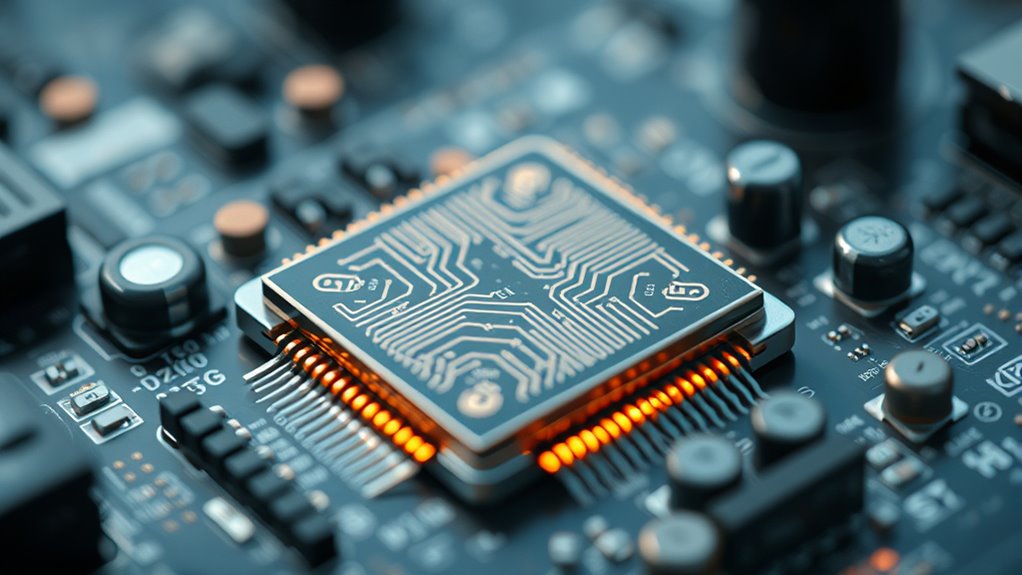Edge-AI chips are tiny but mighty processors embedded in devices, enabling them to analyze data instantly without relying on cloud connectivity. They provide faster responses, lower latency, and improved privacy by handling complex tasks like facial recognition or voice commands locally. These chips are designed to be energy-efficient, tackling size, power, and heat challenges while supporting diverse applications. To discover how these silicon giants are shaping the future of smart tech, keep exploring further.
Key Takeaways
- Edge-AI chips process data locally on devices, enabling real-time analytics without relying on cloud connectivity.
- They are designed to optimize power efficiency, allowing long device operation with minimal energy consumption.
- These chips incorporate advanced architectures and neural accelerators to handle complex AI tasks swiftly.
- Their compact size and thermal management innovations facilitate integration into small, portable, and low-power devices.
- Continuous advancements make edge-AI chips smarter and more versatile, supporting diverse applications and future AI developments.

Have you ever wondered how smart devices process data so quickly without relying on the cloud? The answer lies in edge-AI chips—tiny silicon giants that bring powerful computing directly to your devices. These chips are designed to perform complex tasks locally, reducing latency and improving real-time responsiveness. But achieving this level of performance isn’t without its hurdles.
One of the biggest challenges is power efficiency. Unlike traditional processors that might draw significant energy, edge-AI chips need to operate efficiently within the limited power budgets of small devices like smartphones, drones, or IoT sensors. Every milliwatt counts, so designers focus on optimizing hardware to deliver maximum processing power while consuming minimal energy. This delicate balance ensures that devices can run longer on a single charge, making edge-AI technology more practical and accessible.
Edge-AI chips must maximize processing power while minimizing energy use for practical, long-lasting smart devices.
Innovation challenges also play a significant role in the development of edge-AI chips. Pushing the boundaries of what these tiny processors can do requires overcoming hurdles related to size, heat dissipation, and computational capacity. Engineers endeavor to pack more transistors into smaller footprints, which involves advanced fabrication techniques and novel chip architectures.
But shrinking chip size can lead to increased heat generation, risking thermal management issues that could impair performance or cause hardware failure. Furthermore, balancing high-performance AI algorithms with limited hardware resources demands innovative solutions—such as specialized neural network accelerators—that enable these chips to process data efficiently without resorting to the cloud.
Another challenge is guaranteeing these chips can handle diverse tasks across different applications. Whether it’s facial recognition, voice processing, or environmental monitoring, edge-AI chips must be versatile yet optimized for specific functions. This requires designing flexible hardware that can adapt to various AI models while maintaining power efficiency.
Additionally, the rapid evolution of AI models means these chips need to be future-proof—capable of handling new algorithms and increasing computational demands without becoming obsolete quickly. This ongoing innovation requires constant research, testing, and refinement, making the development process both complex and resource-intensive.
Despite these challenges, the progress in edge-AI chip technology is impressive. They’re becoming more efficient, smarter, and more capable than ever before. As they evolve, they’ll continue to transform how we interact with technology—delivering real-time insights and seamless experiences directly at the device level.
The tiny silicon giants are paving the way for a future where smart devices act faster, smarter, and more independently, all while overcoming the hurdles of power efficiency and innovation challenges.
Frequently Asked Questions
How Do Edge-Ai Chips Differ From Traditional Processors?
You might wonder how edge-AI chips differ from traditional processors. These chips focus on neural optimization, enabling them to handle AI tasks more efficiently right at the source.
They prioritize power efficiency, reducing energy consumption while maintaining high performance. Unlike traditional processors, edge-AI chips are designed specifically for real-time analytics, making them ideal for on-device processing.
This capability speeds up decision-making and reduces reliance on cloud computing.
What Are the Main Challenges in Developing Edge-Ai Chips?
You face challenges in developing edge-AI chips, mainly due to managing power consumption and manufacturing complexity. These chips need to operate efficiently with limited energy, requiring innovative designs to minimize power use without sacrificing performance.
Additionally, manufacturing tiny, complex silicon components demands advanced processes and precision, which can increase costs and production time. Overcoming these hurdles is essential to create reliable, high-performing edge-AI solutions for real-time analytics.
How Secure Are Edge-Ai Chips Against Cyber Threats?
You might wonder how secure edge-AI chips really are against cyber threats. While they incorporate cybersecurity vulnerabilities protections like data encryption, they’re still susceptible to attacks if not properly secured.
Ensuring secure firmware updates and physical protections helps mitigate risks. You should stay vigilant about potential vulnerabilities and implement robust security measures, since even tiny chips can become targets for cybercriminals seeking to exploit sensitive data or disrupt operations.
Can Edge-Ai Chips Be Integrated Into Existing Devices Easily?
Imagine upgrading your device like adding a sleek new engine to a familiar car. You might wonder if edge‑AI chips fit smoothly into your existing setup.
While many are designed for device compatibility, retrofit challenges can arise, requiring careful integration. Still, manufacturers are working to make this process easier, so you can enjoy real-time analytics without overhauling your current systems.
It’s a promising step toward smarter, more efficient devices.
What Future Innovations Are Expected in Edge-Ai Chip Technology?
You’ll see future innovations in edge-AI chip technology focus on neural network optimization and reducing power consumption. These advancements will make chips more efficient, enabling faster processing and longer battery life in your devices.
Expect smarter, more adaptable chips that handle complex tasks locally, minimizing reliance on cloud data. This evolution will power a new wave of real-time analytics, making your devices more responsive and energy-efficient without sacrificing performance.
Conclusion
So, step into the world of tiny titans—edge-AI chips—that transform tech trends. These miniature marvels make mighty moves, mastering real-time insights with unmatched agility. As you witness their wondrous workflows, you’ll wonder how these tiny titans tackle towering tasks with such tenacity. Embrace the evolution, energize your experience, and enjoy the exhilarating edge these exceptional silicon sentinels provide. Power, precision, and promise—edge-AI chips are truly the future’s formidable force.










